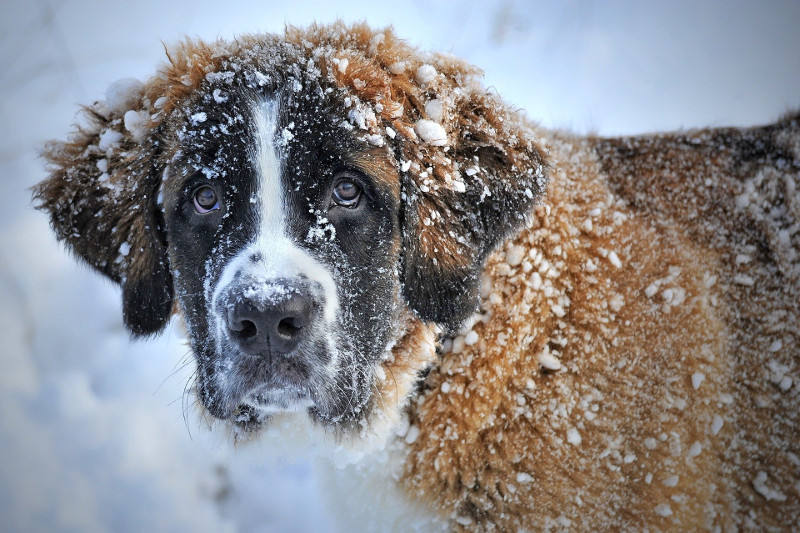During the winter months, it can be nice to stay indoors to keep warm on the coldest days. As pet owners know, that’s not always a possibility. No matter the weather, your pooch still requires regular walks for exercise, mental stimulation, and of course to do their business.
As the weather continues to get more frigid in the Georgian Bay area, there are a few things dog owners should keep in mind when it comes to safe winter outings.
When is it too cold to walk my dog?
The answer to this question can vary wildly, depending on your dog’s breed and tolerance to the elements. Certain breeds, like Bernese Mountain Dogs, Siberian Huskies, and Alaskan Malamutes have a thick, insulating undercoat to protect from the harshest winter conditions. Many dogs, however, do not have this luxury. Dogs with finer coats, like Dachshunds, Boston Terriers, and French Bulldogs, often require a well-insulated jacket to retain body heat that would otherwise be lost to bitter winter weather.
In general, when temperatures dip below 0°C, it is time to start taking some basic safety precautions, like a well-fitted sweater or jacket. Look for well-made garments that have a waterproof outer shell, as well as an interior insulating layer.
Coats need to fit properly to do their job well. Coats that are too big will not do an adequate job of retaining body heat, as cold air will penetrate the loose space between your dog’s body and their coat. Furthermore, coats that are too small will be uncomfortable, and will not provide adequate coverage of your dog’s core.
Once outdoor temperatures reach -10°C or below, it is advised to limit outdoor time to necessary bathroom breaks only as prolonged exposure to these glacial temperatures may be unsafe.
No matter your dog’s breed, however, there’s one thing to always keep in mind; when temperatures begin to drop below freezing, no dog should be left outside for an extended period of time without close supervision.
Don’t forget the paws!
We have all had chapped lips at one point in time, and we can all agree that it is not a pleasant feeling. Now, imagine if your dog had that on his feet. Ouch!
Not only does winter pose a threat in terms of temperature, the combination of freezing conditions and dry air can wreak havoc on our dog’s feet. Consider the many elements our dog’s sensitive paws are exposed to throughout the winter. From snow and ice, to salt and sand, it should come as no surprise that many dogs struggle with their paws during the coldest months of the year. For these dogs, decent foot protection is of utmost importance.
Protective footwear for dogs has come a long way in terms of quality, comfort, and ease of use. They’ll keep your pooch’s paws warm and dry, provide much needed traction on slippery surfaces, and will act as a protective barrier from ice and salt.
While all dogs can benefit from protective footwear, not all dogs require them. When returning from a walk, it is advisable to take a moment to wipe your dog’s paws. This will help to remove harsh chemicals that come from road salt, de-icing agents, and anything else they may have picked up during their outings.
Be sure to regularly check your dog’s pads for signs of dryness and cracking. Also check in between the toes for obstructions, and check the toenails for splitting. Dry pads can greatly benefit from a paw balm, as it helps to moisturize and allows the foot to heal faster.
This also goes for dog noses, too! Wintry conditions can cause sensitive sniffers to become chapped, as well. Nose balms are a safe and effective remedy for this, so be sure to keep an eye on your dog’s nose as the temperatures continue to drop.
With the right precautions, winter outings can be a fun and rewarding time to spend with our best four-legged friends. Let’s get out and enjoy the beautiful winter wonderland we live in!
Brandon Forder, known as The Pet Expert, is vice-president of Canadian Pet Connection, an industry leader in healthy pet lifestyles. Brandon is certified in pet nutrition, and has more than twenty-five years experience specializing in pet health and behaviour. He has written hundreds of informative pet-related articles for newspapers, magazines, radio, and the popular Ask the Pet Expert Blog. Brandon is highly skilled in pet problem solving, and enjoys teaching others about smart and responsible pet ownership. To learn more, visit www.CanadianPetConnection.ca.












